
The opossum is a unique and fascinating creature native to the Americas. One of its most distinctive features is its pouch, which is located on the belly of the female opossum. The opossum pouch is used to carry and nurse the young, known as joeys, until they are old enough to venture out on their own.
The female opossum pouch is an incredible adaptation that allows the mother to carry her young with her wherever she goes. The pouch is lined with soft fur and has a small opening at the top, which the joeys use to climb in and out. The mother opossum has the ability to control the opening of the pouch, allowing her to keep her young safe and secure inside.
Opossums are marsupials. This means they give birth to an undeveloped young that continues to grow outside of the womb. The joeys are born after a very short gestation period and immediately crawl into the mother's pouch. Once inside, they attach themselves to one of her teats and remain there for several weeks, nursing and growing. The female opossum pouch is a remarkable adaptation that allows these unique creatures to thrive in their environment.
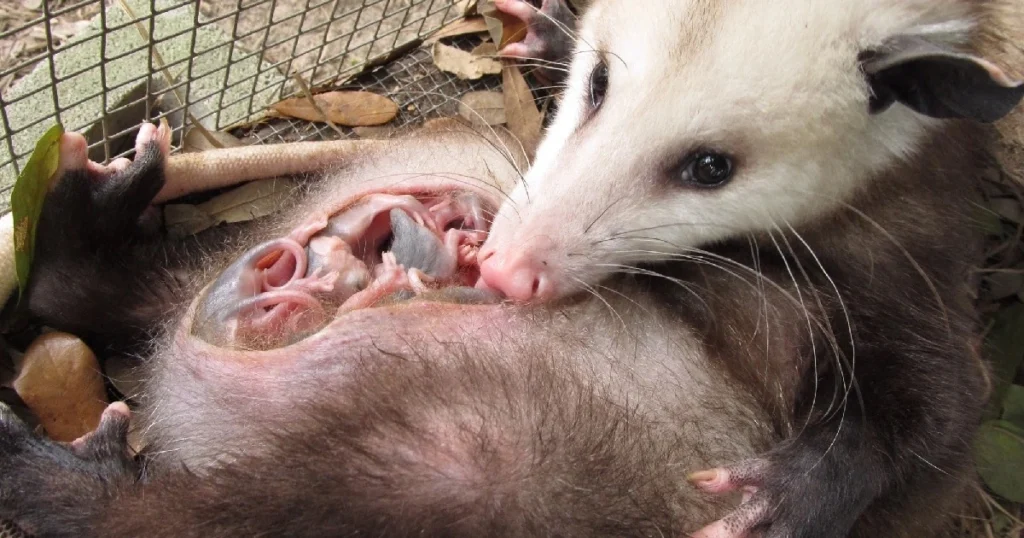
Opossum pouches are a unique feature of female opossums. It's a skin fold located on the abdomen that opens towards the tail. The pouch is used to carry and nurse opossum babies, also known as joeys. The structure of the pouch is simple yet effective. It is composed of two layers of skin that form a pocket-like structure. The inner layer secretes milk, which nourishes the developing joeys. The outer layer protects the joeys from harm and keeps them warm.
The opossum pouch is a remarkable adaptation that allows the opossum to carry its young in a safe and secure manner. The pouch is also an important part of the opossum's reproductive system, providing a nurturing environment for the joeys to develop and grow.
The development of the opossum pouch begins during the embryonic stage. The skin on the abdomen of female opossums begins to thicken and fold inward, forming the pouch, which fully develops when the opossum reaches sexual maturity.
Once the female opossum becomes pregnant, the pouch becomes active. The inner layer of the pouch begins to secrete milk, which nourishes the developing joeys. The joeys are born after a short gestation period and crawl into the pouch, where they attach themselves to a teat and begin to nurse.
As the joeys grow and develop, the pouch expands to accommodate their increasing size. The joeys remain guarded in the pouch for a couple of months until they are large enough to leave and explore the world on their own.
In conclusion, the opossum pouch is a remarkable adaptation that allows the opossum to carry and nurse its young safely and securely. The pouch's structure and function are simple yet effective, and its development and maturation are closely tied to the reproductive organs of the female opossum.

Opossums are known for their unique reproductive behaviors. Mating typically occurs during the winter months, and males compete for access to females. During mating, the male grasps onto the female's back using his fore and hindlimbs to support himself. This position is known as the "copulatory lock," and it can last for several hours.
After mating, the female opossum will give birth to a litter of young, which are called joeys. The gestation period for opossums is relatively short, lasting only around 12 to 14 days. Once the joeys are born, they are very small and undeveloped, weighing only around 0.13 grams each.
The joeys will immediately crawl into the female's pouch, where they will continue to develop and nurse for several months. The pouch is unique to most marsupials and provides a safe and protected environment for the developing young. The female opossum will carry her babies in her pouch for around 2 to 3 months, after which they will begin to venture out and explore the world on their own.
Overall, opossum reproductive biology is fascinating and unique. From their mating behaviors to the development of their young, these animals have adapted to their environment in remarkable ways. Whether you encounter an opossum with babies or an opossum with babies in a pouch, remember these animals play a role in their ecosystem, and treating them with respect and care goes a long way.
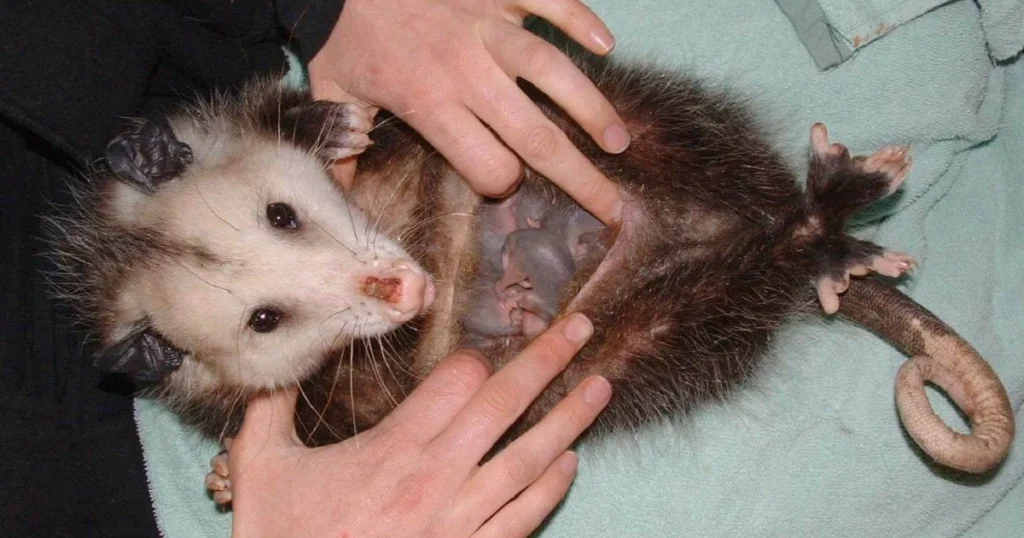
Mother opossums are known for their unique way of carrying and protecting their young. They have a specialized pouch located on their belly where the babies are born and spend the first few months of their life. This pouch provides a safe and warm environment for the young to grow and develop.
The mom opossum with babies in her pouch is a common sight in the wild. The pouch has a small opening at the top. The babies crawl into the pouch shortly after birth and attach themselves to one of the thirteen nipples inside. The mom opossum carries her young in the pouch for up to three months, providing them warmth, protection, and milk.
The mom opossum is very protective of her young and will defend them fiercely if threatened. She will hiss, growl, and bare her teeth to deter predators. If the danger persists, she may play dead to avoid being attacked. This is a survival mechanism that has evolved over time and has proven to be very effective in protecting the young.
As the babies grow and develop, they become too big for the pouch. At around three months old, they begin to venture out of the pouch and ride on their mom's back. This is the weaning process, and it takes a few months for the cub to become fully independent.
During this time, the mom opossum continues to provide her young with milk and protection. She teaches them to find food and water and how to avoid danger. Once the young are fully weaned, they leave their mother behind and go off on their own.
The interaction of opossums' mothers and offspring is fascinating and unique. The specialized pouch provides a safe and warm environment for the young to grow and develop, while the mom opossum provides them with milk and protection. The weaning process is gradual and allows the young to become fully independent over time.
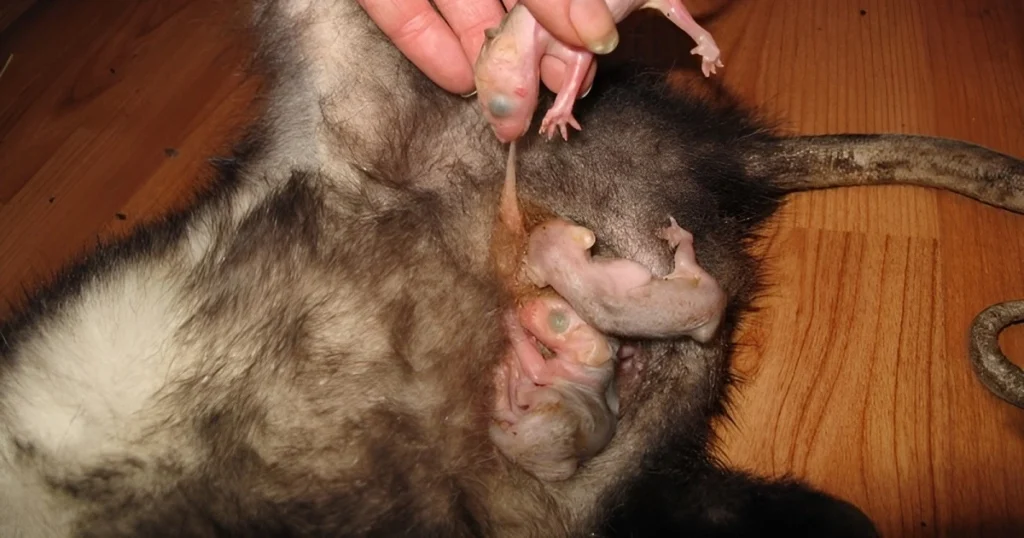
If you wonder what to feed a baby opossum, it’s important to understand their dietary needs. In the wild, baby opossums rely on their mother's milk for the first few weeks of life. If you are learning how to feed a baby opossum, it’s essential to provide them with the right nutrition to ensure their healthy growth and development.
Opossum milk is different from other mammalian milk in terms of its composition. It is high in protein, calcium, and phosphorus but low in fat and lactose. The protein content of opossum milk is almost twice that of cow's milk, making it an ideal food for baby opossums.
If you are caring for a baby opossum, you may need to provide them with supplemental feeding. You can purchase a commercial milk replacer specifically formulated for opossums from a pet store or online. Alternatively, you can make your own milk replacer by mixing goat's milk, egg yolks, and a few other ingredients.
It’s important to note that a baby opossum in pouch has a high metabolic rate and requires frequent feedings so you might need a baby opossum feeding chart. A baby opossum under four weeks of age should be fed every two to three hours, while those between four and eight weeks of age can be fed every four hours.
Once they are old enough, baby opossums can be fed solid foods in addition to milk. Some good options include fruits, vegetables, cooked chicken, and scrambled eggs. However, it’s important to avoid feeding them dairy, as they are lactose intolerant.
If you have found an orphaned opossum, it's important to take proper care of it until it can be released back into the wild. Here are some tips for caring for orphaned opossums.
Feeding an orphaned opossum can be challenging, but it's important they get the proper nutrition so they achieve optimal growth and development. It’s recommended to feed them a specially formulated milk replacer that is high in protein, low in fat, and contains the vitamins and minerals they need. Some good brands include Esbilac and Fox Valley.
In addition to milk replacer, you can also offer them small amounts of fruits, vegetables, and insects as they get older and start to wean off of the milk. Some good options include bananas, sweet potatoes, scrambled eggs, and mealworms.
It's important to note that opossums have unique dietary requirements and should not be fed cow's milk or cat food, as these can cause digestive issues and other health problems.
Orphaned opossums require a warm and safe environment to grow and develop. A plastic storage container or pet carrier lined with soft bedding material can make a suitable temporary home. You should also provide them with a hide box or nest box to give them a sense of security.
When handling an opossum, it's important to wear gloves to protect yourself from scratches and bites. Opossums are generally docile and non-aggressive, but they can become defensive if they feel threatened. The best you can do is approach them slowly while avoiding sudden movements or loud noises.
In conclusion, caring for orphaned opossums requires patience, dedication, and knowledge of their unique needs. By providing them with proper nutrition and a safe environment, you can help them grow and develop into healthy adults that can be released back into the wild.
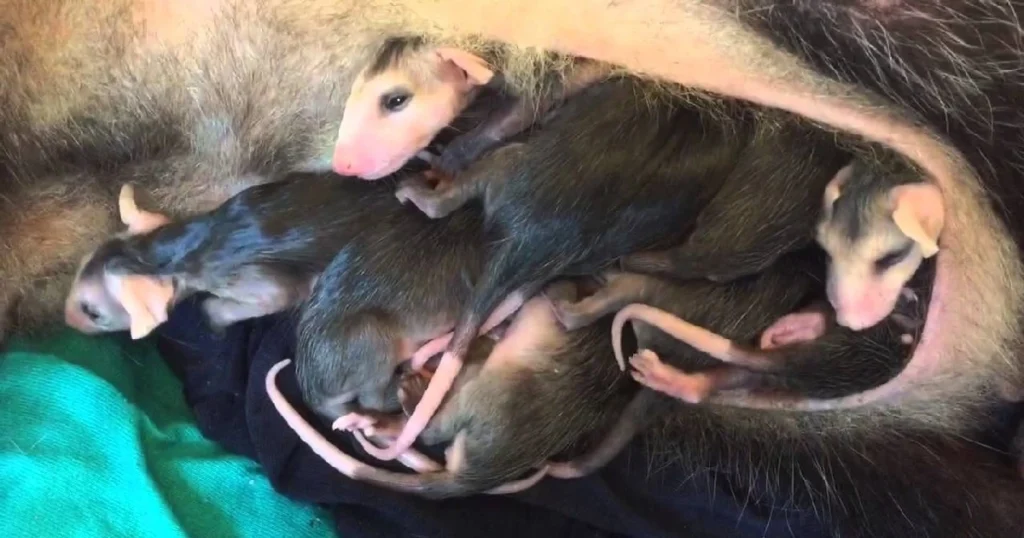
Opossums are known to be relatively healthy animals. However, they are susceptible to certain illnesses that can be potentially life-threatening. One of the most common illnesses in opossums is parasitic infections, such as fleas, ticks, and mites. These parasites cause skin irritation, hair loss, and other health issues in humans.
Another common illness in opossums is leptospirosis, a bacterial infection that can cause fever, vomiting, and dehydration. Opossums can also suffer from respiratory infections, such as pneumonia, which can be caused by exposure to cold temperatures or damp environments.
Proper care of your opossum is important to prevent these illnesses. This includes providing a clean and dry living environment, regular veterinary check-ups, and sticking to a healthy baby opossum diet. Baby opossums, in particular, require a specialized diet that includes a mix of fruits, vegetables, and protein sources such as insects, eggs, and cooked meat.
Regular veterinary care is important to ensure the opossum remains healthy. This includes vaccinations against common diseases, such as distemper and rabies, and regular check-ups to monitor for any signs of illness or infection.
In addition to proper care and veterinary attention, it is also important to take preventive measures to protect your opossum from parasites and other potential health hazards. This includes regularly checking for signs of fleas, ticks, and mites, as well as keeping your opossum away from potentially contaminated water sources.
In conclusion, while opossums are generally healthy animals, they are still susceptible to certain illnesses and health concerns. By providing proper care, regular veterinary attention, and taking preventive measures, you can help ensure that your opossum remains healthy and happy.
The opossum is found throughout North and South America, but human activities such as deforestation and urbanization threaten its habitat. In response, conservation efforts have been made to protect the opossum's habitat.
One of the most effective ways to preserve the opossum habitat is through the establishment of protected areas, such as national parks and nature reserves. These areas are managed to ensure that the opossum habitat remains intact and that the species can continue to thrive.
In addition to habitat preservation, public awareness campaigns are important in conserving the opossum. These campaigns aim to educate people about its importance and its role in the ecosystem.
Public awareness campaigns can take many forms. You can promote educational programs in school, community events, or social media campaigns. By raising awareness about the opossum, people are more likely to take action to protect the species and its habitat.
Overall, conservation efforts for the opossum are crucial to ensure its survival. Through habitat preservation and public awareness campaigns, we can work towards a future where the opossum can continue to thrive in its natural habitat.
Opossums have been featured in various cultures and mythologies throughout history. In Native American folklore, opossums are often seen as tricksters, using their ability to play dead as a way to deceive predators. In some African cultures, opossums are associated with healing and are used in traditional medicine.
In modern times, opossums have become a popular symbol of resilience and adaptability. Their ability to survive in many environments and their unique defense mechanisms have made possums something worth studying.
While opossums are not commonly kept as pets, some people have taken an interest in raising them. It is important to note that in many states, it is illegal to keep opossums as pets without a permit.
Those who do keep opossums as pets often describe them as affectionate and playful but also prone to mischief. Opossums require a specialized diet and environment, and proper care should be taken to ensure their health and well-being.
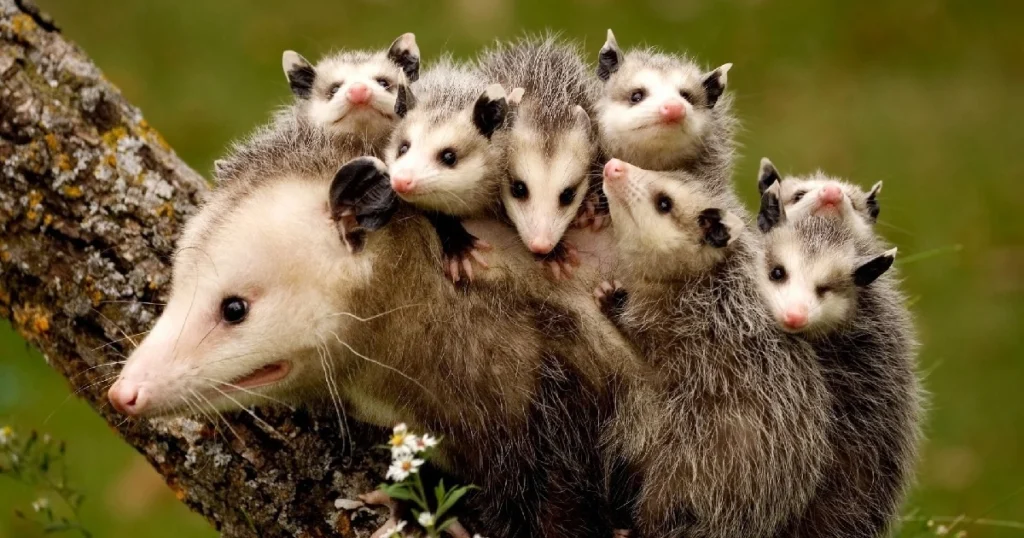
While opossums may be cute and fascinating creatures, they can be a nuisance when they take over homes or properties. That’s why it’s important to take action to get rid of them. However, opossums are protected by law in many states, and it’s illegal to harm or kill them. That’s why it’s important to call in the experts to get them relocated safely and humanely.
One such expert is Critter Stop, a professional humane wildlife removal company with years of experience removing opossums from properties and relocating them to safe and suitable habitats. They use humane trapping methods and take care to ensure that the opossums are not harmed in any way during the removal process.
Critter Stop also provides a range of other wildlife removal services, including the removal of raccoons, squirrels, bats, and more. The company uses the latest techniques and equipment to ensure the removal process is safe, efficient, and effective.
If you have opossums on your property, don't hesitate to call Critter Stop at (214) 234-2616. Their experts will assess the situation, provide you with a quote, and carry out the removal process in a safe and humane manner. With Critter Stop, you can rest assured that your problem will be taken care of promptly.
Baby opossums, also known as joeys, remain in their mother's pouch for approximately 2 to 3 months. During this time, they attach themselves to their mother's teats and feed on her milk.
The maximum number of offspring a mother opossum can carry in her pouch is 13. However, the average litter size is around 7 to 8 joeys.
Opossum joeys leave the pouch at around 2 to 3 months of age. They are not fully weaned at this point and will continue to nurse from their mother for a few more weeks while also beginning to eat solid foods.
No, male opossums do not have a pouch. Only female opossums have a pouch, which they use to carry and nurse their young.
Opossums transport their young by carrying them in their pouch. The pouch is a unique feature of female opossums and is located on their belly. The young opossums attach themselves to their mother's teats and feed on her milk while in the pouch.
The dimensions of an opossum's pouch can vary depending on the size of the mother opossum. On average, the pouch is around 4 to 5 inches long and 3 to 4 inches wide. It is lined with fur to provide warmth and comfort for the young joeys.
You can feed a baby opossum, a specialized formula designed for orphaned wildlife, which is available at wildlife rehabilitation centers or bought online. Avoid dairy; it can cause digestive issues, as possums are notoriously lactose intolerant.
Visit our Critter Library and learn more about our furry friends